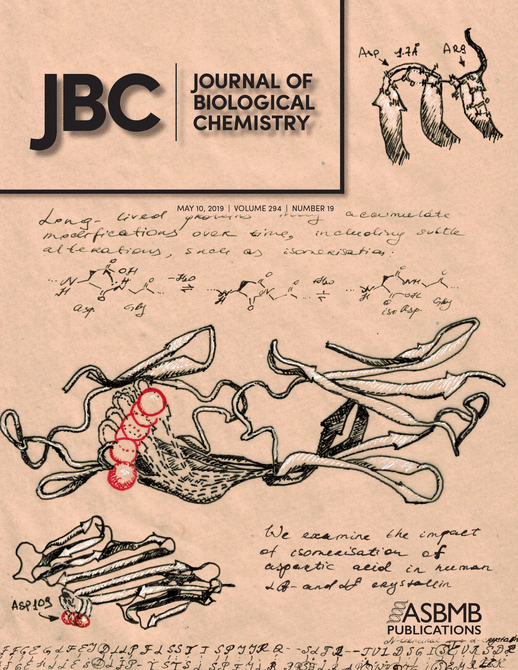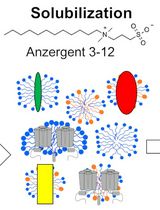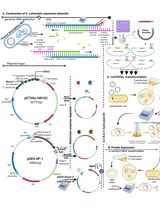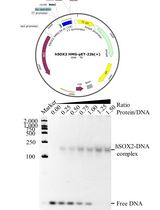- EN - English
- CN - 中文
Preparation, FPLC Purification and LC-FT-ICR-MS of Proteins
蛋白质的制备、FPLC纯化及LC-FT-ICR-MS
发布: 2020年04月05日第10卷第7期 DOI: 10.21769/BioProtoc.3570 浏览次数: 4638
评审: David PaulAnonymous reviewer(s)
Abstract
High magnetic field Fourier transform ion cyclotron resonance (FT-ICR) mass spectrometers provide extremely high mass resolution (resolving power of ~200,000 at 400 m/z) protein detection across a broad mass range, enabling analysis of fine structure of isotopic peak clusters that is missed in other types of mass spectrometers. The protocol detailed here describes preparation of cellular extracts for purification of DNA-binding proteins using multiple chromatographic chemistries via fast protein liquid chromatography (FPLC), and identification and quantitation of the protein isoforms and their post-translational modifications by liquid chromatography coupled to Fourier transform ion cyclotron resonance mass spectrometry (LC-FT-ICR-MS). This protocol benefits from selectively purifying proteins for identification and quantitation by high resolution FT-ICR, which has the resolution to definitively distinguish between acetylation and trimethylation post-translational modification (PTM) additions.
Keywords: FT-ICR (傅里叶变换离子回旋共振)Background
Post-translational modifications (PTMs) of proteins play very important roles in regulation of cellular processes and function. The characterization of PTMs is challenging because of the large number of potential modifications and number of amino acid residues that can be modified. This can be particularly true for proteins with a limited number of proteolytic sites that cannot be analyzed in proteolytically digested forms and require an intact protein MS analysis. To achieve this goal, this protocol describes a combination of protein separation by HPLC and high accuracy/resolution mass spectrometry. The HPLC separation helps to; 1) eliminate various salts and other interfering molecules from the protein of the interest, 2) separate various PTM isoforms of the protein, and 3) improve ionization of the protein. A high accuracy/resolution MS instrument is, on the other hand, necessary to identify specific charge envelopes and isotope pattern distribution that are the important features essential for an accurate PTM determination. Although results of the intact protein MS analysis depend on many factors including a molecular mass, amino acid composition and tertiary structure of proteins, usually it can only be achieved by two types of MS instruments: Fourier transform ion cyclotron resonance mass spectrometer (FT-ICR-MS) or recently developed generations of the Orbitrap-based mass spectrometer. Of those, FT-ICR-MS is preferred as data can be acquired at higher resolution and accuracy. On the other hand, this instrument requires liquid helium to keep the magnet temperature low which increases maintenance cost. Electrospary Ionization (ESI) used in mass spectrometry of intact proteins generates many different charge states of the protein. This represents a potential problem in detection of PTMs of the protein as peaks corresponding to individual proteoforms must be resolved. Therefore, only mass spectrometers with high resolving power such as FT-ICR-MS can be used. Depending on a magnetic field, they can have the resolving power at 1,000,000 and still accuracy between 0.05 and 1 ppm.
Materials and Reagents
- Nitrile gloves
- 15-ml Amicon centrifugal filter units 3 kDa MWCO (Millipore Sigma, catalog number: UFC900308 )
- Pipette tips 1,000 µl, 200 µl, 20 µl, 2 µl
- Serological pipets
- 1.5 ml Microcentrifuge tubes
- 1.7 ml low retention microtubules (PHENIX Research Products, catalog number: MAX-715L )
- 15 ml conical tubes
- Disposable borosilicate glass tubes (Fisher Scientific, catalog number: 14-961-29 )
- 30 ml syringe
- 10 ml syringe
- 60 ml syringe
- 0.45 µm filtration apparatus
- 0.45 µm mixed cellulose ester gridded filters (Millipore Sigma, catalog number: HABG04700 )
- 1-ml HiTrap SP HP prepacked columns (GE Healthcare, catalog number: 17115101 )
- 1-ml HiTrap Heparin HP prepacked columns (GE Healthcare, catalog number: 17040601 )
- Spectra/Por 3 RC Dialysis Membrane Tubing 3500 Dalton MWCO (Spectrum, catalog number: 132724 )
- Reverse phase HPLC column (Thermo Scientific, ProSwift RP-10R 1 mm x 50 mm, catalog number: 164586TS )
- 20% ethanol
- Sodium phosphate, monobasic (NaH2PO4)
- 0.5 M EDTA
- DL-dithiothreitol, anhydrous (DTT) (Millipore Sigma, catalog number: D9779 )
- Potassium chloride (KCl) (Millipore Sigma, catalog number: 31248 )
- HPLC-grade water (Millipore Sigma, catalog number: 270733 )
- 0.1% formic acid in water (Millipore Sigma, catalog number: 576913 )
- 0.1% formic acid in acetonitrile (CH3CN) (Millipore Sigma, catalog number: 576956 )
- Ammonium sulfate ((NH4)2SO4)
- Sodium hydroxide (NaOH) (Millipore Sigma, catalog number: 1.06462 )
- Hydrochloric acid (HCl) (Millipore Sigma, catalog number: H1758 )
- 4-20% Mini-PROTEAN TGX Precast Protein Gels (Bio-Rad, catalog number: 4561096 )
- 50 mM Ammonium bicarbonate (NH4HCO3) pH 8.0
- Buffer A (see Recipes)
- Buffer B (see Recipes)
Equipment
- Pipettes (P1000, P200, P20, P2)
- Sonicator (Qsonica, Q500 sonicator, catalog number: Q500-110 )
- Centrifuge (Sorvall RC-6+)
- ÄKTA pure FPLC system (or similar liquid chromatography system) https://www.gelifesciences.com/en/gb/shop/chromatography/chromatography-systems/akta-pure-p-05844
- High pressure liquid chromatography capillary pump (Agilent, 1100 Series HPLC, model: CapPump/G1376A )
- Autosampler (Agilent, 1200 Series, model: MicroWPS/G1377A )
- Degasser (Agilent, 1200 Series, model: Degasser/G1379B )
- Fourier-transform ion cyclotron resonance mass spectrometer (Bruker, 7T solariX 70 Hybrid FTMS System, model: 277070 )
Software
- UNICORN 7 control software for ÄKTA pure FPLC system
- HyStar 3.4 software (Bruker)
- Compass SolariXcontrol (Bruker) software
- Compass Data Analysis software version 4.0 (Bruker, https://www.bruker.com/service/support-upgrades/software-downloads/mass-spectrometry.html)
- IDCalc software (MacCoss Lab, https://proteome.gs.washington.edu/software/IDCalc/)
Procedure
文章信息
版权信息
© 2020 The Authors; exclusive licensee Bio-protocol LLC.
如何引用
Readers should cite both the Bio-protocol article and the original research article where this protocol was used:
- Johnson, T. B., Adamec, J. and Blum, P. (2020). Preparation, FPLC Purification and LC-FT-ICR-MS of Proteins. Bio-protocol 10(7): e3570. DOI: 10.21769/BioProtoc.3570.
- Johnson, T., Payne, S., Grove, R., McCarthy, S., Oeltjen, E., Mach, C., Adamec, J., Wilson, M. A., Van Cott, K. and Blum, P. (2019). Methylation deficiency of chromatin proteins is a non-mutational and epigenetic-like trait in evolved lines of the archaeon Sulfolobus solfataricus. J Biol Chem 294(19): 7821-7832.
分类
生物化学 > 蛋白质 > 翻译后修饰
生物化学 > 蛋白质 > 分离和纯化
分子生物学 > 蛋白质 > 检测
您对这篇实验方法有问题吗?
在此处发布您的问题,我们将邀请本文作者来回答。同时,我们会将您的问题发布到Bio-protocol Exchange,以便寻求社区成员的帮助。
提问指南
+ 问题描述
写下详细的问题描述,包括所有有助于他人回答您问题的信息(例如实验过程、条件和相关图像等)。
Share
Bluesky
X
Copy link












